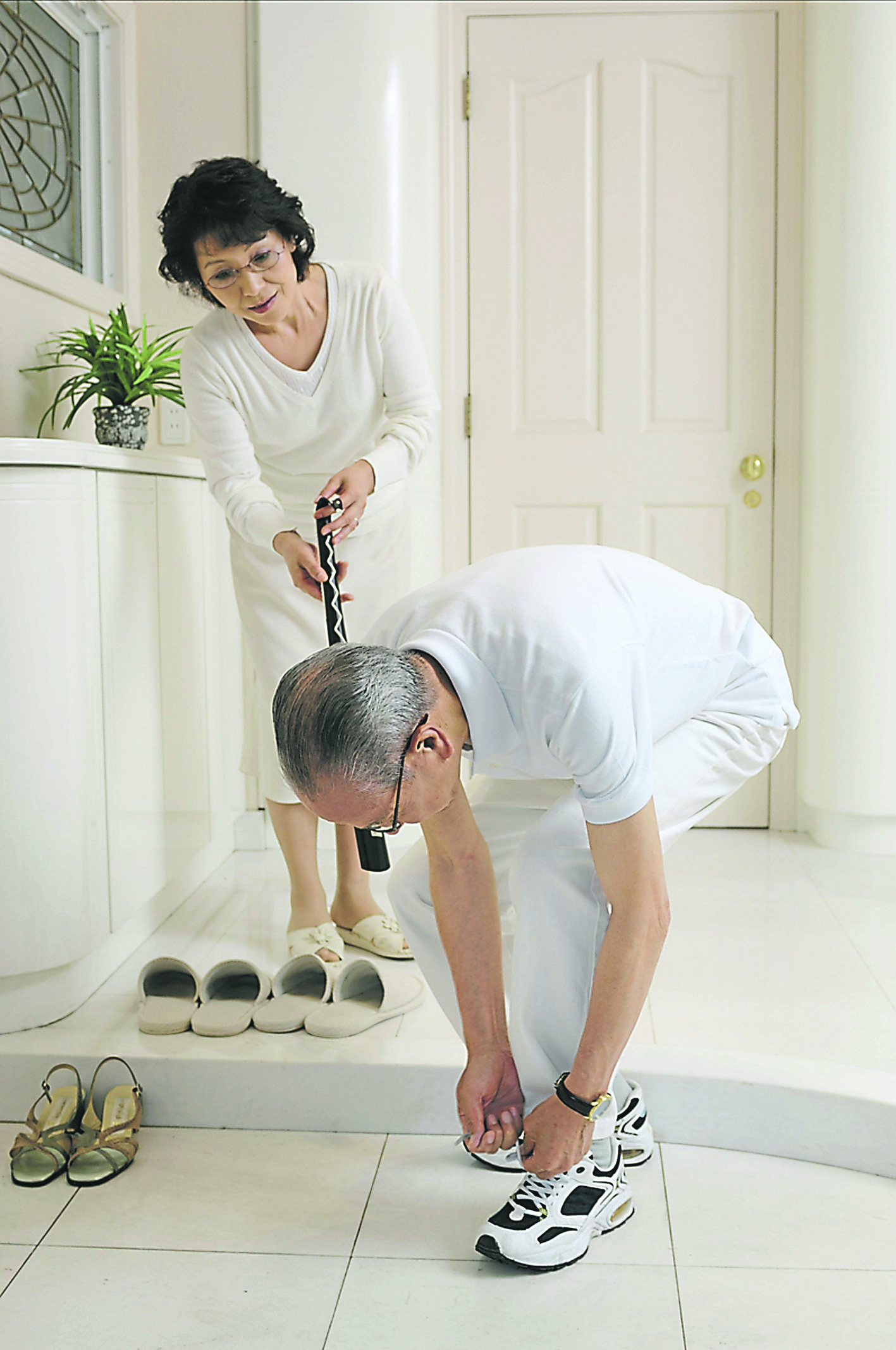[Wan Qing Yi Care]Every 10 falls will result in serious injury: 10 tips for preventing falls for the elderly
[ad_1]
Text◆Liang Yanchun “Health”
Old people can’t fall! Falls among the elderly are an issue that should be taken seriously. Falls are the second leading cause of accidental injuries among those over 65 years old.
Serious falls in the elderly can lead to long-term bed rest and even death due to other infections and complications. How can they be effectively prevented?
(Taipei News) Sima Zhongyuan, known as the “Master of Ghost Stories”, passed away at the age of 90. Family members revealed that Sima Zhongyuan was sent to the hospital for treatment after he fell while walking. The doctor originally assessed that he needed to install steel nails, but after he was transferred to the general ward, he discovered that he had an infection problem. Unexpectedly, he eventually developed acute pneumonia and passed away.
Falls are the main cause of accidental death among the elderly, and falls are the second leading cause of accidental injury death among those over 65 years of age. A serious fall for the elderly can lead to long-term bed rest or death. Not only does the elderly suffer, but the burden on the caregivers also increases. How can it be effectively prevented?
Fear of falling again restricts activities
According to U.S. statistics, falls are the leading cause of accidental death among people over the age of 65. Based on domestic and foreign research results, the annual incidence of falls in the elderly is about 15 to 40%, and it increases with age.
Because the elderly often have comorbidities with a high prevalence of
(comorbid diseases),
Such as osteoporosis, organ function deterioration,
Even a minor fall can cause significant danger.
Foreign research points out that
One in 10 falls in the elderly results in serious injury.
Including hip fractures, fractures of other parts,
Subdural hemorrhage, soft tissue injury, or head trauma.
In addition, some elderly people are afraid of falling again.
And restricting one’s own activities,
Gradually losing the ability to act independently,
It makes the body function worse and worse, and also creates a burden on the family.

2 factors causing elderly people to fall
Lin Songkai, the attending physician of the Rehabilitation Department, analyzed the causes of falls in the elderly and can be summarized into two categories:
Intrinsic factors: including deterioration of physical functions (vision, hearing, balance, coordination, musculoskeletal system), medical diseases (such as Parkinson’s disease, stroke, diabetes), drugs, and postural hypotension.
External factors: including environment, clothing, and accidental injuries.
Many experts have proposed the following 10 prevention methods for the causes of falls in the elderly:
1. Proper lighting
Occupational therapist Ji Zhou believes that adequate lighting is the most basic requirement. Because the eyesight of the elderly gradually deteriorates, their ability to adjust light is not as good as it used to be. Therefore, keeping bright lights within the elderly’s activity range is the first step to prevent falls.
“But the light should not be too dazzling, and reflections from bright floors and furniture should be avoided, otherwise it will easily cause interference and increase the visual impairment of the elderly.”
In addition, in order to meet the needs of the elderly to go to the toilet at night, in addition to a permanent night light in the room, sensor-type lights can also be installed in the corridors, thresholds or steps of the route to avoid tripping over obstacles. Providing sufficient identification brightness at the light switch (for example, a tiny light source inside the switch and a sticker that glows at night) can save the elderly from the embarrassment of searching on the wall for a long time to find the switch.
2. Clean moving lines
The basic principle of environmental layout for seniors is “the simpler the space planning, the better”. Ji Zhou reminded that before planning, you must first understand the daily routine of the elderly, and then “clear all obstacles” within the normal movement range, including thresholds, stacked debris, furniture, and wires, because the movements of the elderly are relatively inflexible. Poor eyesight makes it easy to trip over obstacles.
“Remove the threshold of more than 3 centimeters.” Ji Zhou suggested that because the elderly lift their feet to cross the threshold, their center of gravity will be concentrated on one foot and they will easily fall.
3. Obvious signs
“When obstacles cannot be removed, add obvious signs.” Ji Zhou’s many years of experience found that “colors are easier to identify than words. It is recommended to put brightly colored or strongly contrasting tape on obstacles (such as thresholds and steps). or paint), helps remind.”
4. Anti-slip flooring
The living room floor can be covered with rough-surfaced plastic floor tiles, and the bathroom floor can also be made of good-grip, non-polished material.
If you don’t want to invest in extensive construction work to renovate the floor, Ji Zhou recommends putting anti-slip strips on the walking paths of your elders, especially in places where they are prone to falling, such as bathrooms, stairs, and places where you get out of bed. The spacing between the stickers should be smaller than the length of the sole of the foot. For example, if the size of the foot is 30 centimeters, then tape one strip every 25 centimeters.
As for the assembled plastic mats that are often placed in the bathroom to prevent slipping, “it must be spread throughout the bathroom.” Xie Dewang, a lecturer in the Department of Commercial Design at Mingchuan University, reminded, “Scattered and unfixed mats are more likely to slip.”
5. Stable handrails
Liang Weicheng, a doctor in the emergency department of China Medical University Hospital, said that walkways, stairs and bathrooms should all be equipped with handrails. If the elderly fall, they can grab the handrails immediately, which can slow down the momentum of the fall and avoid serious injuries.
In addition, adding armrests to chairs, toilets and beds can help the elderly get up and sit down, reducing the burden on the legs; adding armrests to door thresholds and next to bathtubs can help the elderly maintain balance when raising one foot.
The height of the handrail installed at home is adjusted according to the individual’s height. It is generally about 70 to 90 centimeters from the ground. “When the arm is slightly bent when grasping, there will be a point of application of force,” Ji Zhou reminded.
6. Thoughtful bathroom
The bathroom is the most slippery place, and it is also the focus of preventing the elderly from falling. Anti-slip floors and necessary handrails are basic requirements.
Jizhou strongly recommends not to use the bathtub, because the height of the bathtub is about 45 cm, and you have to lift one foot very high when entering, making it easy to fall. If it is not convenient to remove, you must install stable handrails next to it and make anti-slip devices inside and outside the bathtub.
Xie Dewang suggested placing non-slip and non-slip chairs in shower rooms and wash basins so that elders can sit down and rest when they are tired of standing.
In addition, it is also a good method to use a water intercepting ditch and a shower curtain to separate the wet and dry areas of the shower room and toilet without installing a threshold.
7. Friendly stairs
Research statistics show that more than 70% of falls occur at home, and about 10% of them occur in stairwells, especially when going down stairs.
When stairs are an unavoidable design, Li Yingqi, a physiotherapist at Mackay Hospital, called for “the design of stairs for the elderly in their homes must achieve the goals of ‘stepping on the steps firmly’, ‘raising the steps high’, and ‘holding the handrails firmly'” Target.”
She suggested that the tread of the steps should be wide enough to accommodate 80 to 90% of the foot surface, about 25 to 30 centimeters; considering that the elderly have insufficient lower limb muscle strength and do not have enough strength to lift their thighs when going up the stairs, the height of the steps should not exceed 15 cm; in addition, the distance between the armrests on both sides is no more than 1 meter, so that the elderly can easily hold it firmly.
In addition, since the elderly have reduced sensitivity to light and color, contrasting colors that are easy to distinguish should be used for step surfaces and step surfaces. Bright colors should be used for step surfaces, and dark colors should be used for step surfaces.
Many elderly people have fallen accidents because they missed the last step when going down the stairs. Ji Zhou specifically reminded that the handrails of the stairs must be extended an additional 30 centimeters after the last step to allow the elderly to step on them steadily.
8. The right furniture
Chairs that are too low and too soft (such as sandals) are not suitable for the elderly, “because standing up and sitting down are difficult movements for the elderly.”
Ji Zhou said that it is best to have a design with handrails. “In order to reduce injuries when falling, you can add anti-collision strips or foam to the sharp points of furniture.”
Lin Songkai believes that clothes and trousers that are too long or too wide, shoes that are old or severely worn, and shoes with poor anti-slip ability may all cause the risk of falls for the elderly.
Buying a pair of shoes that fit well and have anti-slip function for the elder in the family is like adding insurance for every step he takes.
9. Safe medication use
Lin Songkai pointed out that some drugs may cause side effects of dizziness and increase the risk of falls, such as blood pressure lowering drugs, sedatives, sleeping pills, muscle relaxants, diuretics, cold medicines, antihistamines, etc.
Dr. Li Jiaming and Dr. Chen Jingying from the Department of Family Medicine reminded that the elderly at home should check whether the medications they take pose a risk of falling, or if they are taking more than four medications at the same time. You can discuss with your doctor to consider reducing the dose or stopping unnecessary medications.
When taking these medications is unavoidable, the elders should be reminded to rest more and slow down after taking the medication.
10. Exercises to enhance leg strength
The American College of Sports Medicine (ACSM) points out that a combination of balance training, resistance exercise, walking, and weight shifting can help reduce the risk of falls. Research by Lin Yingzhou, an attending physician at the Rehabilitation Department of Chang Gung Memorial Hospital, and others has also confirmed that practicing Tai Chi can effectively prevent falls in the elderly and reduce complications after falls.
[ad_2]
Source link

![[Love Wants Sexual Happiness Series 358]Find the culprit and overcome psychogenic erectile dysfunction. Don’t let pressure affect your sexual happiness.](https://chinathenews.com/wp-content/uploads/2024/04/171111-780x420.jpg)

![[Wanqingyi Care]My health, my rights, customized medical methods in the last stage of life](https://chinathenews.com/wp-content/uploads/2024/04/ZZ1-100-780x420.jpg)
![[Kidney Transplantation Special Topic]The survival rate of transplanted kidneys is high without dialysis treatment three times a week](https://chinathenews.com/wp-content/uploads/2024/04/1311-780x420.jpg)



